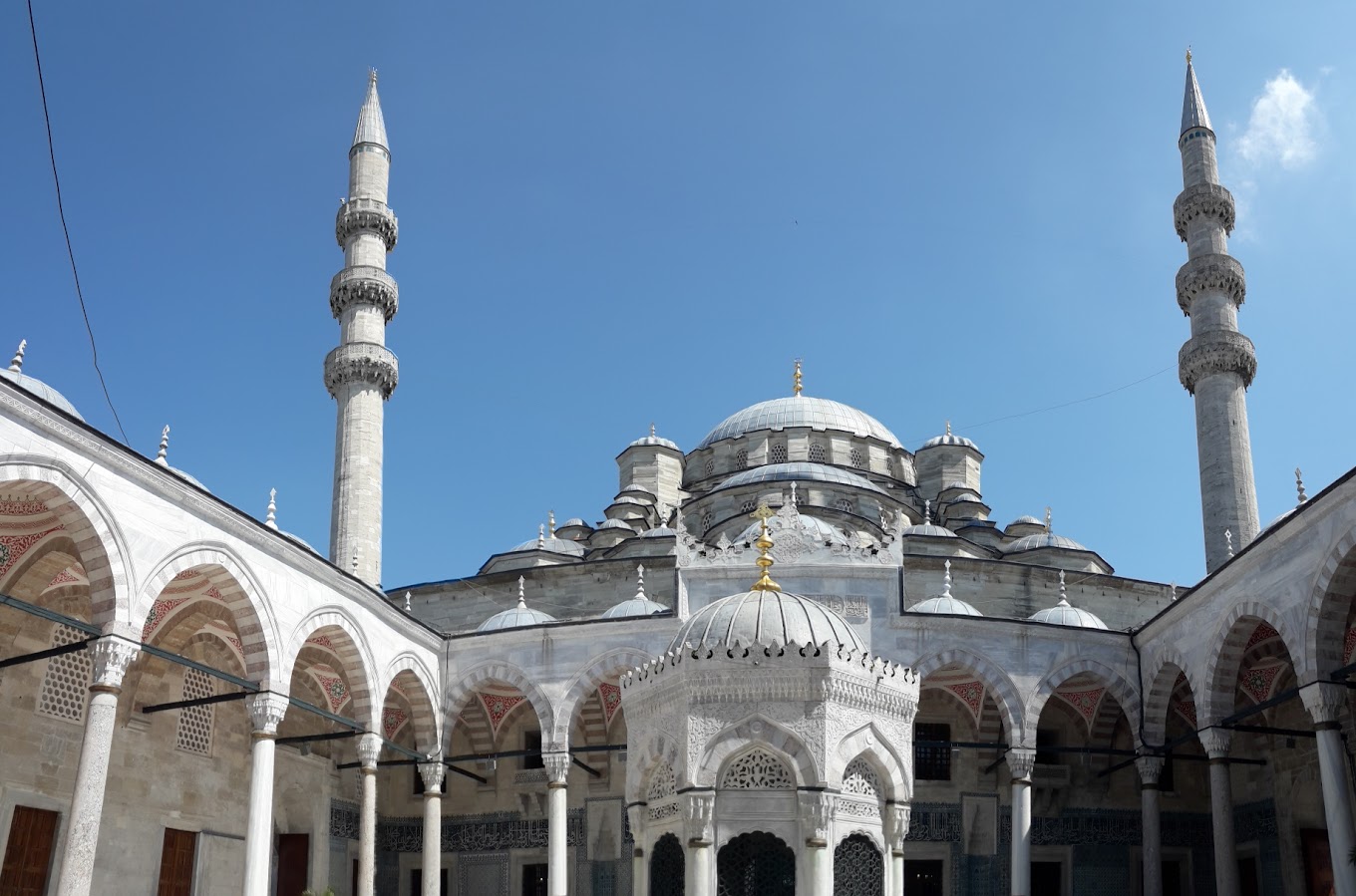
The Yeni Camii, meaning “New Mosque” in Turkish, is not new by modern standards but holds a significant place in history. Construction began in 1597 under the order of Sultan Safiye, the wife of Sultan Murad III. However, due to political struggles and financial difficulties, the Istanbul new mosque’s completion was delayed. It wasn’t until 1665 that the mosque was finally completed under the supervision of Sultan Mehmed IV’s mother, Hatice Turhan Sultan.
Table of Contents
Introduction to the Yeni Mosque
The Influence of the Ottoman Empire
During the time of its construction, the Ottoman Empire was at its peak, and the mosque’s design reflects the grandeur and power of the empire. The Yeni Camii was intended to be a centerpiece of a larger complex that included a marketplace, a school, and a hospital, embodying the empire’s commitment to community welfare and Islamic education. The architectural style was a testament to the empire’s wealth and the sultanate’s desire to leave a lasting legacy through monumental structures.
The New Mosque was part of a broader urban development plan initiated by the sultans to showcase the empire’s prosperity and cultural zenith. The mosque’s location in the historical peninsula of Istanbul was strategic, ensuring that it was seen by all who entered the city by sea, thereby serving as a symbol of the empire’s dominance.
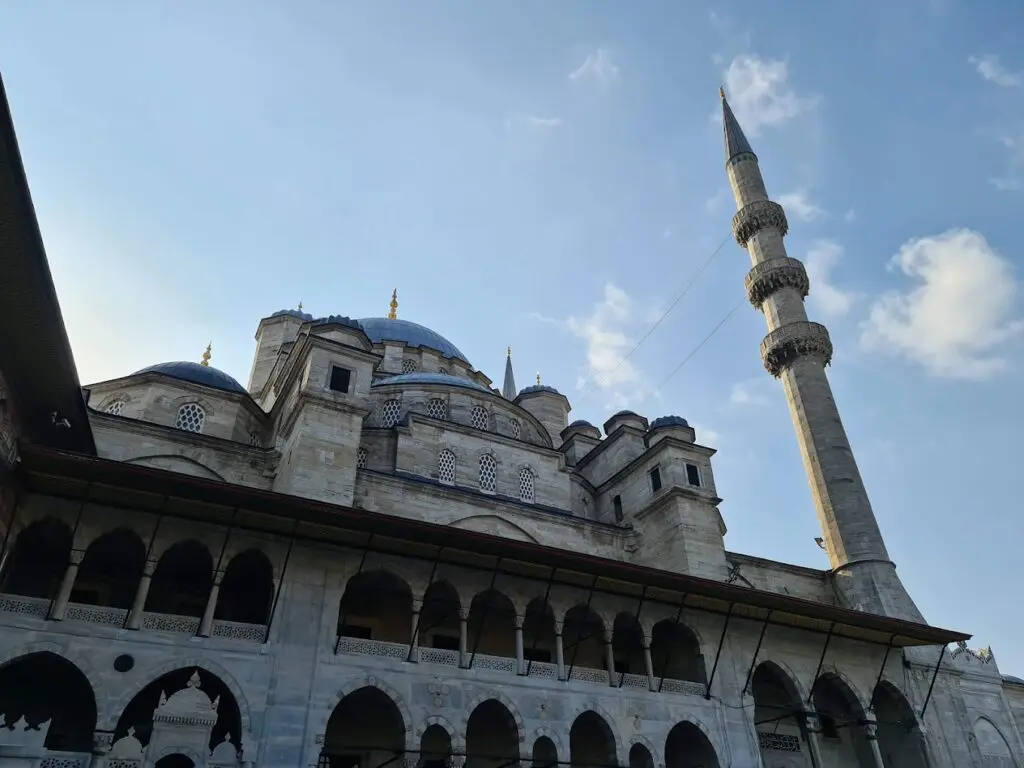
The Role of Women in Its Construction
Interestingly, the New Mosque is one of the few mosques in Istanbul associated with prominent women of the Ottoman period. Both Sultan Safiye and Hatice Turhan Sultan played crucial roles in its construction, showcasing the influence of women in the empire, albeit often behind the scenes. Sultan Safiye’s initial vision for the mosque set the foundations for its eventual completion, while Hatice Turhan Sultan’s determination ensured its realization.
The involvement of these women highlights the often-overlooked contributions of women in Ottoman architectural projects. Their patronage was not just a display of personal devotion but also a means to wield influence and leave a tangible mark on the city’s landscape. This empowerment of women through architectural patronage was a unique aspect of the Ottoman court.
Challenges and Delays
The construction of the Yeni Camii was fraught with challenges, including financial constraints and political upheaval. The initial construction faced resistance from the local janissaries and merchants, who were concerned about the mosque’s proximity to the bustling market area. The project’s funding was also a significant hurdle, as it relied heavily on the sultans’ personal finances and state treasury allocations.
The long delay in the mosque’s completion reflects the complex socio-political dynamics of the time. The eventual completion under Hatice Turhan Sultan’s aegis was a triumph over these adversities, marking a period of stability and renewed focus on monumental architecture in the empire.
Architectural Features of the Yeni Mosque
The Yeni Mosque in Istanbul is a masterpiece of Ottoman architecture. Designed by the renowned architect Davut Ağa, a student of the legendary Mimar Sinan, the mosque displays many classic features of Ottoman design, blending them with elements of Byzantine influence.
The Grand Dome and Minarets
One of the most striking features of the Yeni Mosque is its majestic dome, which reaches a height of 36 meters. The dome is flanked by two minarets, each standing 52 meters tall. These towering structures not only serve a religious purpose but also contribute to the mosque’s imposing presence on the Istanbul skyline.
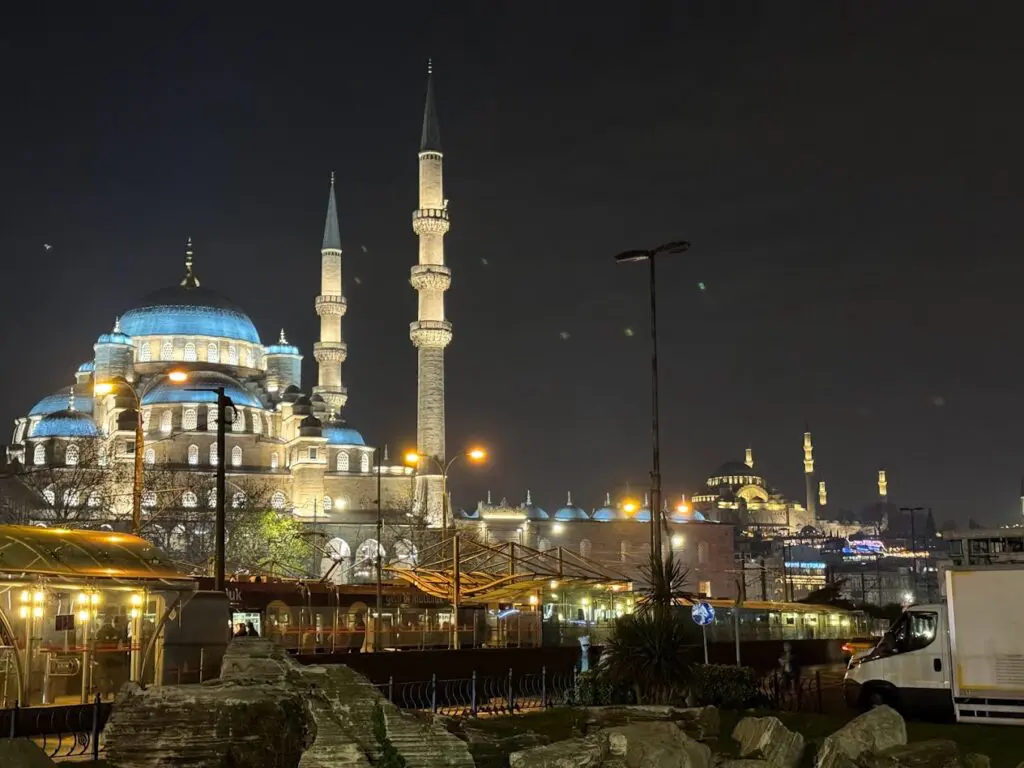
The dome’s design is emblematic of Ottoman architectural innovation, combining structural ingenuity with aesthetic grandeur. The use of a central dome flanked by semi-domes creates a harmonious balance, distributing weight and creating an illusion of spaciousness within the prayer hall. The minarets, with their slender silhouettes, are not only functional but also act as visual anchors that frame the mosque against the city’s skyline.
The Courtyard and Interior Design
The mosque’s courtyard, or avlu, is a serene space surrounded by a colonnade of 24 domed arches. This area serves as a place for worshippers to gather before entering the main prayer hall. Inside, the mosque is adorned with exquisite Iznik tiles, calligraphy, and gold leaf decorations that exemplify the opulence of Ottoman art.
The courtyard is designed to be an oasis of tranquility, offering a respite from the bustling city outside. The meticulous arrangement of the arches and the soothing sound of the central ablution fountain enhance the spiritual ambiance, preparing worshippers for the sanctity of the prayer hall. The interior design is a testament to the artisanship of the time, with intricate patterns and vibrant colors that create a sense of divine beauty and spiritual elevation.
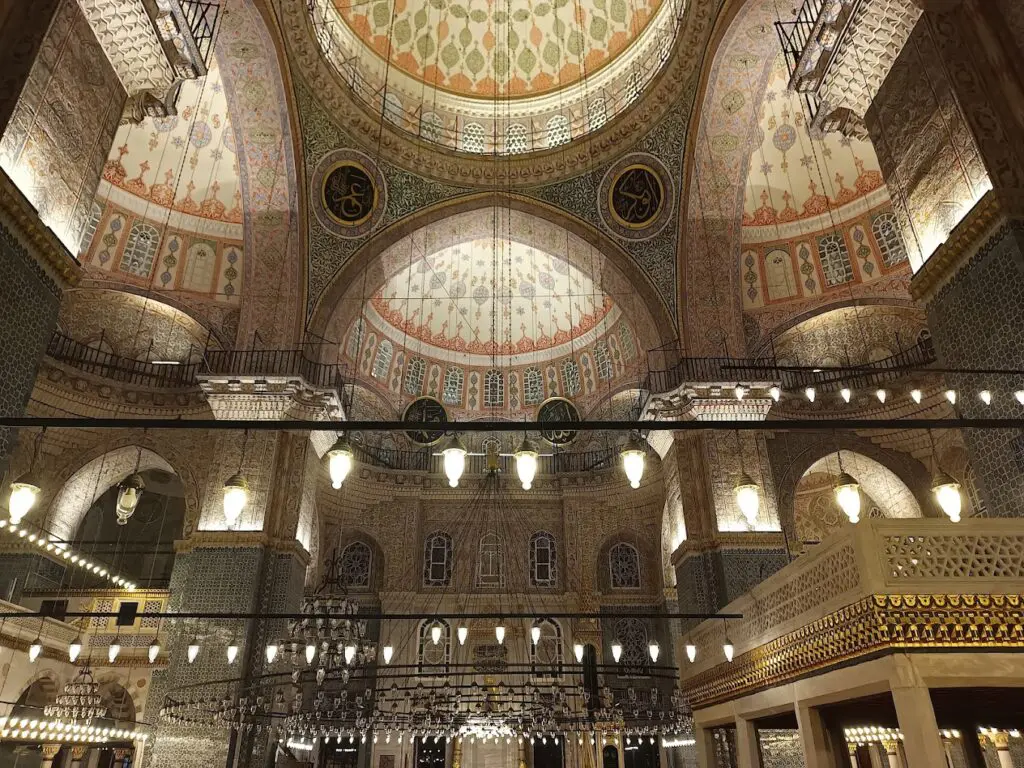
The use of Iznik tiles is particularly noteworthy, as they are considered the pinnacle of Ottoman ceramic art. The tiles’ vibrant colors and intricate floral motifs are a reflection of the empire’s appreciation for nature’s beauty, symbolizing paradise as described in Islamic teachings.
The Use of Light and Space
The design of the Yeni Camii carefully considers the use of light and space. Large windows allow natural light to flood the interior, creating a peaceful and spiritual atmosphere. The spacious layout accommodates large numbers of worshippers, reflecting the mosque’s role as a community hub.
The strategic placement of windows ensures that the mosque is bathed in natural light throughout the day, enhancing the spiritual experience. The interplay of light and shadow within the prayer hall creates an ever-changing ambiance, inviting worshippers to connect with the divine in a serene setting. The emphasis on open space within the mosque reflects the inclusive nature of Islamic worship, welcoming all who seek solace and community within its walls.
The mosque’s layout is also a reflection of Ottoman advancements in architectural design, with a focus on creating an environment conducive to both individual reflection and communal prayer. The harmony between light, space, and structure is a testament to the genius of its architects and their understanding of sacred architecture.
The Cultural and Religious Significance
The Yeni Mosque is not just an architectural wonder but also a significant cultural and religious site. It serves as a place of worship and a symbol of Istanbul’s rich Islamic heritage.
A Hub for Community and Faith
For centuries, the Yeni Mosque has been a gathering place for the local Muslim community. Its location near the bustling Eminönü district means it is easily accessible to both residents and visitors. The mosque continues to host daily prayers, religious events, and festivals, maintaining its role as a central point for faith and community life.
The mosque’s role as a community hub extends beyond religious activities, often serving as a venue for cultural events and educational programs. Its proximity to key commercial areas makes it a focal point for social interaction, fostering a sense of unity and shared identity among Istanbul’s diverse population. The mosque’s enduring presence in the community underscores its importance as a living institution that adapts to the changing needs of its congregation.
The Yeni Mosque‘s significance is further enhanced by its association with significant historical events and figures, embedding it deeply in the cultural consciousness of Istanbul’s residents. Its continued relevance in contemporary society is a testament to its foundational role in shaping the city’s spiritual landscape.
A Tourist Attraction
Today, the Yeni Mosque is one of Istanbul’s most visited attractions, drawing tourists from around the globe. Its historical significance, architectural beauty, and vibrant surroundings make it a highlight for anyone exploring the city. Visitors are welcomed to admire its design, learn about its history, and experience the peaceful ambiance.
The mosque’s allure extends beyond its architectural splendor, offering visitors a glimpse into the rich tapestry of Istanbul’s cultural heritage. Guided tours and informational displays provide insights into the mosque’s history and significance, enriching the visitor experience. The surrounding area, with its lively markets and scenic views, adds to the appeal, creating a multifaceted destination that captivates the senses.
For many tourists, the Yeni Mosque serves as an introduction to the broader context of Ottoman architecture and Islamic art, encouraging further exploration of Istanbul’s historical landmarks. Its accessibility and welcoming atmosphere make it an ideal starting point for a deeper appreciation of the city’s diverse cultural offerings.
Balancing Tradition and Modernity
The Yeni Mosque embodies the delicate balance between preserving tradition and embracing modernity. While it remains a bastion of traditional Islamic architecture and values, it also adapts to contemporary needs, ensuring its relevance for future generations.
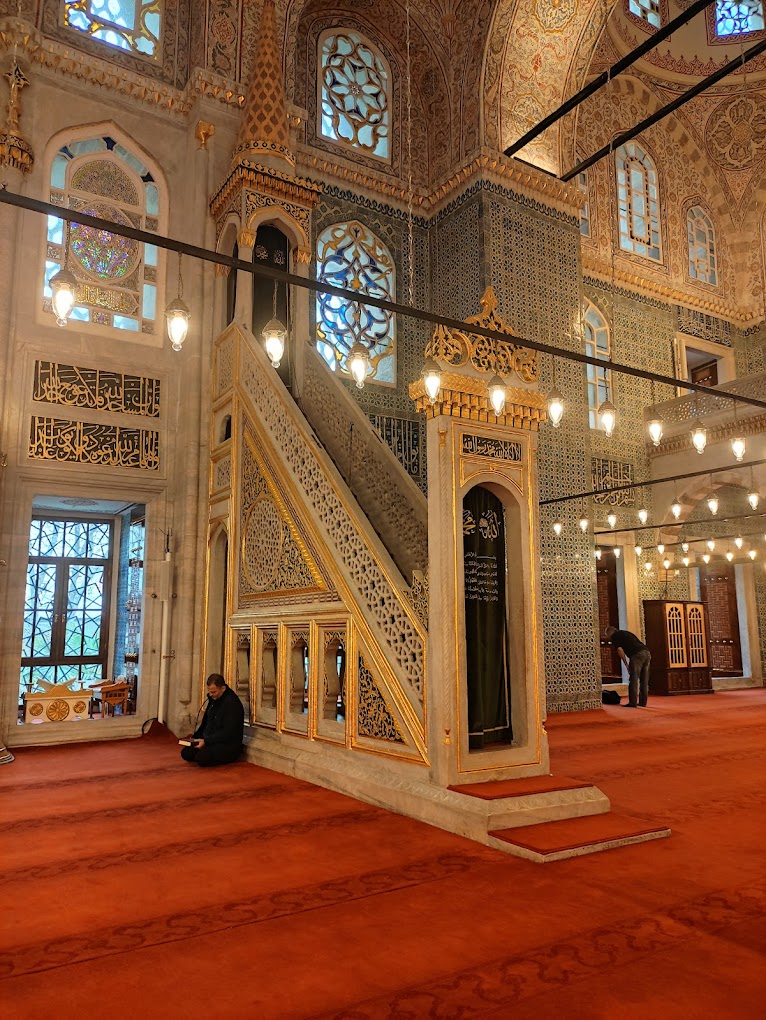
Efforts to maintain and restore the mosque are ongoing, preserving its historical integrity while incorporating modern amenities for visitors and worshippers. This commitment to preservation and innovation ensures that the Yeni Mosque remains a vibrant part of Istanbul’s cultural and spiritual landscape, bridging the past and present in a harmonious blend.
The mosque’s ability to evolve with the times without compromising its core identity is a testament to the resilience and adaptability of Istanbul’s cultural heritage. It stands as a symbol of continuity and change, offering a space where history and modernity coexist in a dynamic dialogue.
Visiting the Yeni Mosque
If you’re planning a trip to Istanbul, a visit to the Yeni Mosque should be high on your itinerary. Here are some tips to enhance your experience:
Best Time to Visit
The mosque is open to visitors daily, except during prayer times when it is closed to non-worshippers. It’s best to visit in the early morning or late afternoon to avoid crowds and enjoy the serenity of the site.
Visiting during these quieter times allows for a more intimate experience, where you can fully appreciate the mosque’s beauty and tranquility. The soft morning light casts a gentle glow on the intricate details, while the evening ambiance provides a peaceful setting for reflection and admiration.

Consider timing your visit to coincide with the call to prayer, as the melodic chants add a layer of spiritual depth to the experience. This immersive encounter offers a unique insight into the mosque’s role in daily life, enhancing your understanding of its cultural and religious significance.
Respectful Practices
When visiting the mosque, it’s important to dress modestly. Women are required to cover their heads, and both men and women should wear clothing that covers their arms and legs. Shoes must be removed before entering, and visitors should remain quiet and respectful inside the mosque.
Adhering to these guidelines ensures a respectful and harmonious visit, allowing you to engage with the mosque’s sacred atmosphere. Modest dress is a sign of respect for the religious customs and traditions upheld within the mosque, fostering a sense of cultural appreciation and understanding.
Being mindful of your behavior and maintaining a quiet demeanor inside the mosque enhances the experience for all visitors, creating a shared environment of reverence and tranquility. This respect for the space and its significance is an integral part of the visiting experience, enriching your connection to the mosque’s history and spiritual legacy.
Exploring the Surrounding Area
The New Mosque is located near several other attractions, including the Spice Bazaar and the Galata Bridge. After exploring the mosque, take some time to wander the vibrant streets of Eminönü, savor local delicacies, and soak in the lively atmosphere of Istanbul.
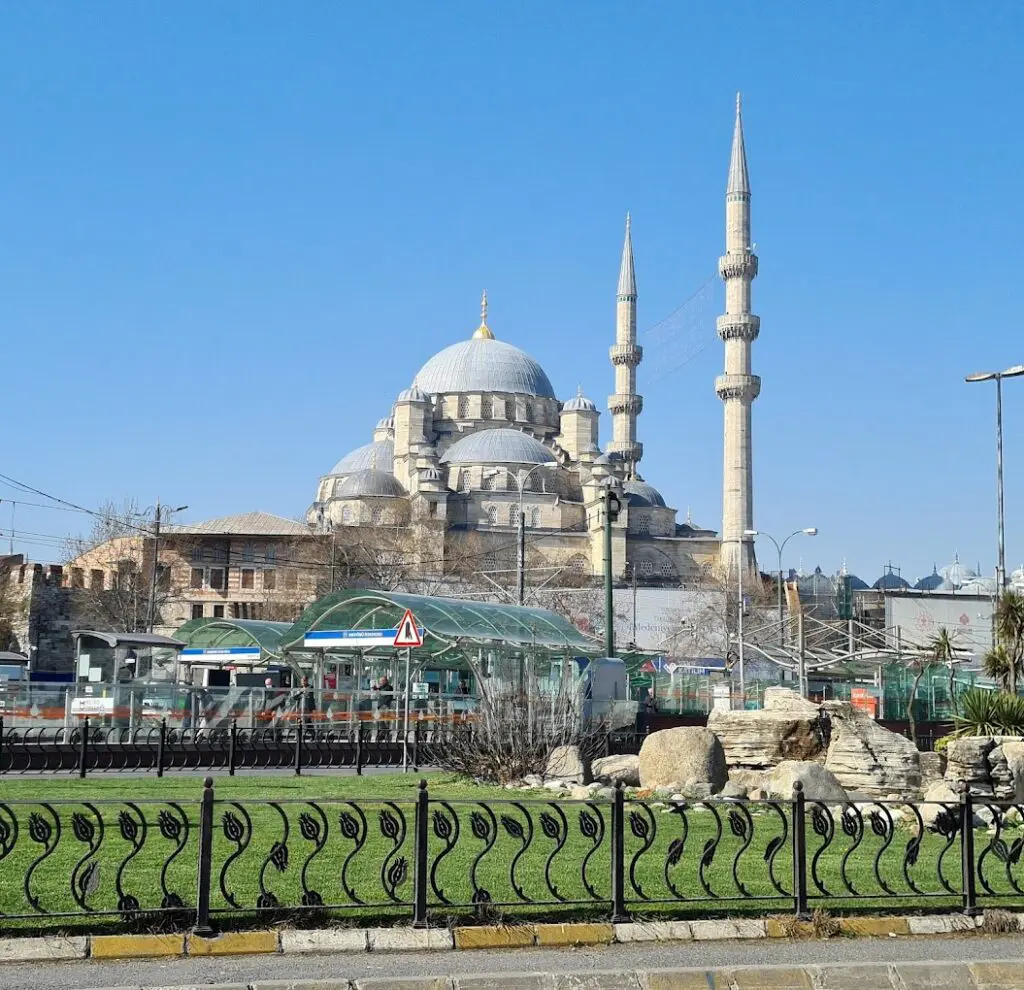
The surrounding area offers a sensory feast, with the vibrant colors and enticing aromas of the Spice Bazaar providing a perfect complement to the mosque’s serene ambiance. Exploring the bustling markets and enjoying the local cuisine adds a layer of cultural richness to your visit, offering a holistic experience of Istanbul’s diverse offerings.
Take the opportunity to stroll along the Galata Bridge, where you can enjoy panoramic views of the city and the Bosphorus. This exploration of the mosque’s surroundings allows you to immerse yourself in the dynamic energy of Istanbul, creating a memorable and multifaceted travel experience.
Conclusion
The Istanbul New Mosque, or Yeni Camii, is a testament to the architectural brilliance of the Ottoman Empire and the enduring faith of the Turkish people. Its rich history, stunning design, and cultural significance make it a must-visit destination for anyone traveling to Istanbul. Whether you’re drawn by its historical intrigue or its aesthetic beauty, the Yeni Mosque offers a unique glimpse into the heart of Istanbul’s past and present. So, make sure to include this architectural marvel in your travel plans and experience the grandeur of the New Mosque in Istanbul, Turkey.
The New Mosque stands as a beacon of cultural heritage and spiritual devotion, inviting all who visit to explore its storied past and vibrant present. Its enduring appeal lies in its ability to captivate the imagination and inspire awe, offering a timeless connection to the legacy of the Ottoman Empire and the rich tapestry of Istanbul’s history. As you wander through its majestic halls and serene courtyards, you’ll discover a world where history, art, and faith converge in a harmonious celebration of human achievement and divine inspiration.
In your journey to Istanbul, let the Yeni Mosque be a focal point of exploration and discovery, guiding you through the city’s captivating blend of tradition and modernity. With each visit, you’ll uncover new layers of meaning and beauty, deepening your appreciation for this iconic landmark and the vibrant city it calls home.
FAQs
1. What is the Istanbul New Mosque?
The New Mosque (Yeni Camii) is a historic Ottoman mosque located in the Eminönü district of Istanbul, near the Spice Bazaar.
2. When was the New Mosque built?
Construction began in 1597 and was completed in 1665 during the reign of Sultan Mehmed IV.
3. Where is the New Mosque located?
It is in the Eminönü district, near the Golden Horn, close to the Spice Bazaar and Galata Bridge.
4. What is the architectural style of the New Mosque?
The mosque features classical Ottoman architecture, with a grand central dome, multiple smaller domes, and elegant Iznik tile decorations.
5. Is there an entrance fee to visit the New Mosque?
No, entry to the New Mosque is free, but donations are appreciated.
6. What are the visiting hours of the New Mosque?
The mosque is open to visitors daily, except during prayer times, particularly on Fridays during Jumu’ah (Friday prayers).
7. What are the main attractions inside the New Mosque?
- The main prayer hall with a stunning dome and intricate tilework.
- The courtyard, offering a peaceful atmosphere.
- The tomb of Hatice Turhan Sultan, the mosque’s patron.
8. Is there a dress code for visiting the New Mosque?
Yes, visitors should wear modest clothing. Women should cover their hair with a scarf, and both men and women should cover their shoulders and knees.
9. How can I get to the New Mosque?
- By Tram: Take the T1 tram line to Eminönü Station.
- By Ferry: Ferries to Eminönü Pier are available from various parts of Istanbul.
- By Bus: Many bus routes stop near Eminönü Square.
10. What is the best time to visit the New Mosque?
Early mornings or late afternoons are best to avoid crowds, especially on weekdays.

